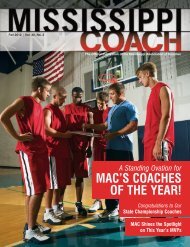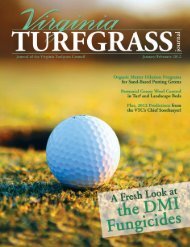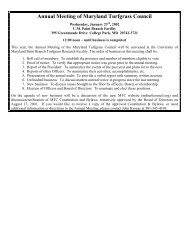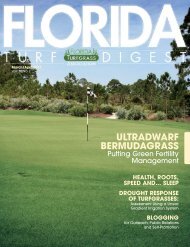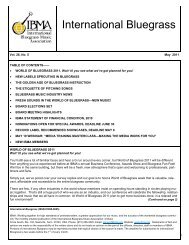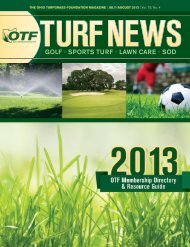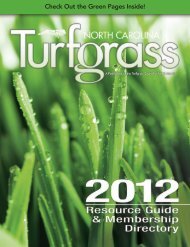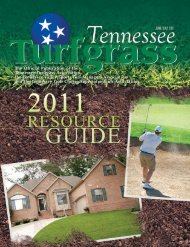the Fate of Field Paspalum Control - The Paginator
the Fate of Field Paspalum Control - The Paginator
the Fate of Field Paspalum Control - The Paginator
You also want an ePaper? Increase the reach of your titles
YUMPU automatically turns print PDFs into web optimized ePapers that Google loves.
PRESIDENT’S MESSAGE<br />
WHAT A<br />
SPRING,<br />
and What We Accomplished!<br />
What a spring we have had!! Back in March, <strong>the</strong> owner <strong>of</strong> a lawncare<br />
company called me to ask, “What <strong>the</strong> heck is going on? Why am I<br />
having to treat dandelions way before I am even thinking <strong>of</strong> applying<br />
pre-emergent herbicides for summer annual grass control? This certainly is not<br />
a normal spring.”<br />
Hmmm… a “normal” spring. I am not sure I remember or even know what<br />
a normal spring is anymore. I have been working in turfgrass for 37 years and<br />
cannot remember two springs being <strong>the</strong> same. We have all chosen to live and<br />
work here in <strong>the</strong> center <strong>of</strong> <strong>the</strong> “transition zone” where our climate is not fit for<br />
any grass to grow without pr<strong>of</strong>essional help, which keeps us all in business. I<br />
still remember <strong>the</strong> first two sentences uttered at <strong>the</strong> beginning <strong>of</strong> my first turfgrass<br />
class at <strong>the</strong> University <strong>of</strong> Maryland many years ago. Dr. Jack Hall started<br />
<strong>the</strong> class by saying, “If you can pr<strong>of</strong>essionally manage turfgrass in Maryland for<br />
five years and keep your job, you can work anywhere in <strong>the</strong> United States.” He<br />
also commented, “<strong>The</strong> best grass in Maryland is green concrete.” Thank goodness<br />
we have such a dedicated group <strong>of</strong> pr<strong>of</strong>essionals who are determined to<br />
make turfgrass not only survive but flourish.<br />
Not only are we constantly battling Mo<strong>the</strong>r Nature, but we <strong>of</strong>ten have to<br />
battle <strong>the</strong> knuckleheads in Annapolis and <strong>the</strong> federal EPA — both think turfgrass<br />
is <strong>the</strong> root <strong>of</strong> all evil and is <strong>the</strong> cause for <strong>the</strong> ruination <strong>of</strong> <strong>the</strong> Chesapeake Bay.<br />
I am not convinced <strong>the</strong>y all think turfgrass is this ultimate polluter. I think some<br />
are just lazy and think turfgrass is an easy target because it is made up <strong>of</strong> a<br />
bunch <strong>of</strong> little companies running around competing with each o<strong>the</strong>r. Little did<br />
<strong>the</strong>y know that <strong>the</strong>se little companies have a big umbrella watching over <strong>the</strong>m,<br />
and that umbrella is called <strong>the</strong> MTC.<br />
This legislative year, Delegates Hubbard, Babe and Clagett and Delegates<br />
Braveboy, Frush, Penna-Melnyk, Wood and Glenn decided to sponsor <strong>The</strong> Fertilizer<br />
Use Act (HB 573). This was part <strong>of</strong> <strong>the</strong> answer to <strong>the</strong> EPA to show that<br />
Maryland was making strides to meet <strong>the</strong> EPA’s arbitrary standards for nitrogen<br />
and phosphorus loads entering <strong>the</strong> Chesapeake Bay. I say arbitrary because<br />
nei<strong>the</strong>r <strong>the</strong> EPA’s standards nor <strong>the</strong> proposed Maryland legislation were based<br />
upon sound scientific bases but instead were being driven mostly by politics.<br />
Fortunately, organizations like RISE and <strong>the</strong> MTC follow legislation that will<br />
affect any <strong>of</strong> our members. A special thanks must go out to Mark Schlossberg<br />
(a former MTC president), Rick LaNore (also a former MTC president and a<br />
current board member) and o<strong>the</strong>rs<br />
who spent hours and days testifying<br />
before legislative committees, meeting<br />
with individual state Senators and<br />
Delegates, sending emails to keep us<br />
all informed and leading letter-writing,<br />
email and phone campaigns, all in<br />
order to develop legislation with<br />
some semblance <strong>of</strong> common sense.<br />
<strong>The</strong> essence <strong>of</strong> this legislation is<br />
probably best explained by Mark<br />
Schlossberg, president <strong>of</strong> Pro-Lawn-<br />
Plus, Inc./M.A.G.I. (MD Assoc. <strong>of</strong><br />
Green Industries, Inc.), in an email<br />
after <strong>the</strong> last session <strong>of</strong> <strong>the</strong> General<br />
Assembly on April 11, 2011:<br />
<strong>The</strong> Fertilizer Use Act was passed<br />
tonight in <strong>the</strong> Maryland General<br />
Assembly on <strong>the</strong> final day <strong>of</strong> <strong>the</strong><br />
session as HB 573. Though this<br />
bill will cost our industry some<br />
money and change <strong>the</strong> way we do<br />
business somewhat, I feel like <strong>the</strong><br />
adjustments we have to make will<br />
not jeopardize our businesses and<br />
golf courses. And <strong>the</strong> fact that we<br />
now will have fertilizer pre-emption<br />
means that we won’t have to worry<br />
about local jurisdictions making<br />
<strong>the</strong>ir own fertilizer laws. We were<br />
able to get <strong>the</strong> final date for fall<br />
N and P applications extended to<br />
December 1st. We’ll still be able<br />
to apply K and limestone between<br />
6 MTC TURF NEWS




